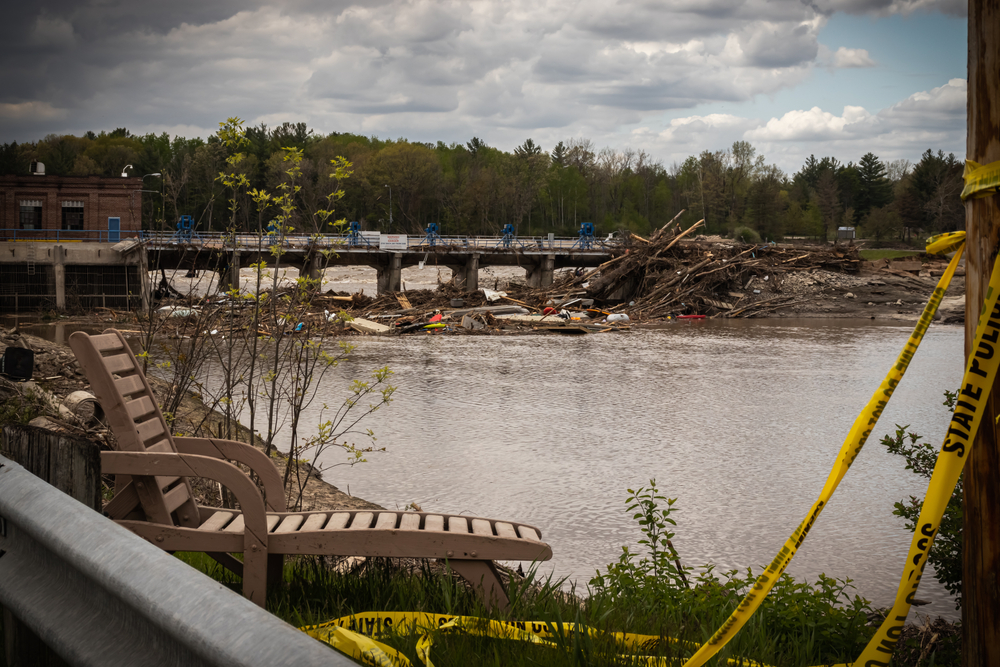The Edenville and Sanford Dams, which failed causing 11,000 people to evacuate their homes in the Midland area, weren’t the only dams whose failure could lead to widespread flooding and potential loss of life.
Of Michigan’s 2,532 dams, 1,153 are regulated by either state (1,061 state) or federal (92) agencies. Of those regulated dams, 803 are privately owned and 350 are publicly owned. The remaining 1,370 smaller dams are not regulated.
Regulated dams are ranked based on their hazard potential downstream impacts were a failure to occur, and on their current infrastructural condition. High hazard dams are defined as those with severe impacts and expected loss of life if a failure were to occur.
The different hazard potential categories were outlined as:
- High – expected loss of life, severe impacts
- Significant – possible loss of life, significant impacts
- Low – no loss of life, minor impacts
These risk categories also dictate how often inspections are required. High hazard potential dams are inspected once every three years, versus significant once every four years. Low hazard potential dams are inspected once every five years. High and significant hazard potential dams are required to have an Emergency Action Plan, which is updated each inspection.
Condition assessments address the dam’s infrastructure and ability to do its job. Each condition is defined below:
- Satisfactory: No existing or potential dam safety deficiencies are recognized. Acceptable performance is expected under all loading conditions.
- Fair: No existing dam safety deficiencies are recognized for normal loading conditions. Rare or extreme hydrologic and/or seismic events may result in a dam safety deficiency.
- Poor: A dam safety deficiency is recognized for loading conditions that may realistically occur. Remedial action or further investigations and studies are necessary to determine risk.
- Unsatisfactory: A dam safety deficiency is recognized that requires immediate or emergency remedial action for problem resolution.
- Not rated: The dam has not been inspected, is not under State jurisdiction, or has been inspected but, for whatever reason, has not been rated.
Of the 85 state regulated high hazard potential dams in Michigan, engineers with the Michigan Department of Environment, Great Lakes, and Energy (EGLE) said six were in poor condition, the Edenville Dam being one of them.
In Southwest Michigan, the Portage Plant Dam in St. Joseph County creates Hoffman Pond, which is about one mile upstream of downtown Three Rivers along the Portage River. Luke Trumble is an engineer with EGLE’s dam safety program, and is tasked with dam surveys across the southern Lower Peninsula.
“The owner of that dam has not submitted an inspection report in some time, and he’s basically been unresponsive ,” Trumble said in a media webinar.
Following a brief inspection by Trumble and a supervisor in 2013, the Portage Plant Dam was listed in poor condition, but EGLE wants to perform a more in-depth inspection in order to determine any more serious issues.
“We want the owner to re-engage and probably perform more of a structural and hydraulic analysis of the dam to identify any critical deficiencies that need to be addressed right away,” Trumble said.
The Portage Plant Dam was built in 1922 according to United States Army Corps of Engineers national inventory of dams, making the structure nearly 100 years old.
Trumble said his team was in the planning stages of enforcement to make sure the dam is operated in a safe condition, but didn’t go into further detail of what enforcement was currently being taken. Escalated enforcement action typically starts with a letter to the owner directing them to develop a plan for addressing the deficiency. If issues aren’t resolved, the state can impose fines or issue orders for repairing the dam.
When a dam is in imminent danger or there is a threat to cause harm to public health, safety, welfare, property, or natural resources, EGLE may eventually step in to alleviate any pressing issues, with the owner recouping cost.
The Michigan Department of Environment, Great Lakes, and Energy (EGLE) released information on the status of five additional dams currently in poor condition with a high-hazard potential.
1. Portage Plant Dam, St. Joseph County
- Owner delinquent/non responsive
- EGLE staff inspected in 2013
- Dam has deteriorated with age, warranting a poor condition assessment
- Planning enforcement action
2. Manistique Papers Dam, Schoolcraft County
- Dam has deteriorated with age, warranting a poor condition assessment
- Owner in bankruptcy proceedings, working with state and federal agencies to remove the dam in the next 3 to 5 years
3. Little Black River Structure B, Cheboygan County
- Sinkhole has formed that is being monitored, warranting a poor condition assessment
- Working with owner to pursue grant funding to repair the dam
4. Buttermilk Creek Detention Dam
- More analysis needed – working with the owner to resolve unauthorized modifications to the dam’s auxiliary spillway
- Does not impact dam’s ability to pass the regulatory design flood (200-year)
- May impact ability to pass larger floods
5. Cornwall Creek Dam, Cheboygan County
- Spillway has deteriorated with age, warranting a poor condition assessment
- State-owned (DNR) – currently working on design, permitting, and funding of full spillway replacement project
This article appeared in WWMT. Read more here.

